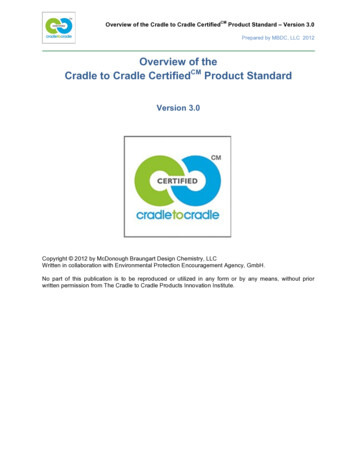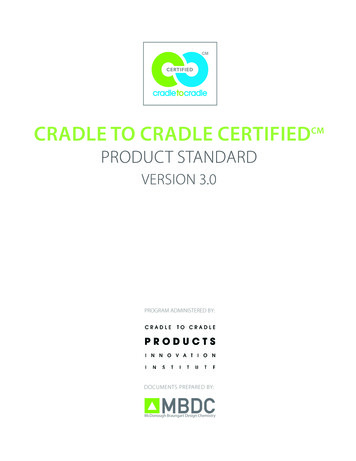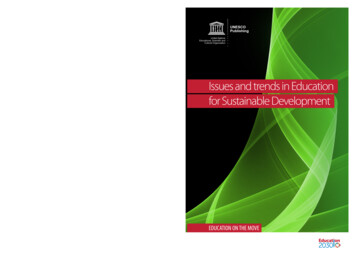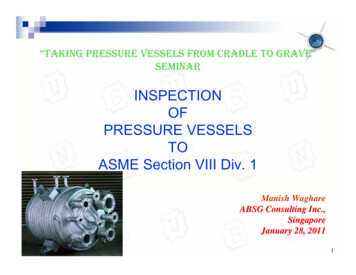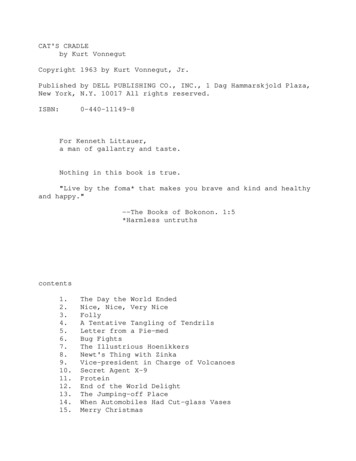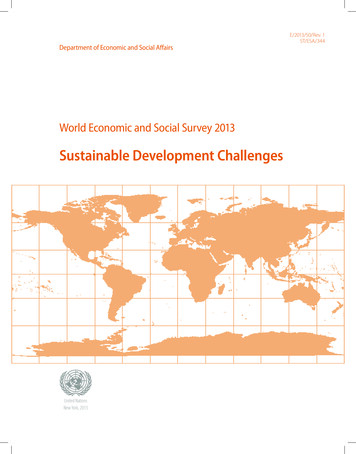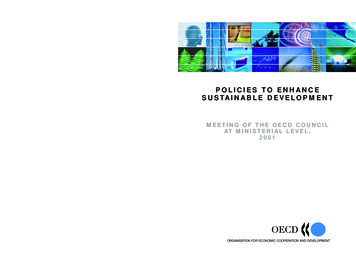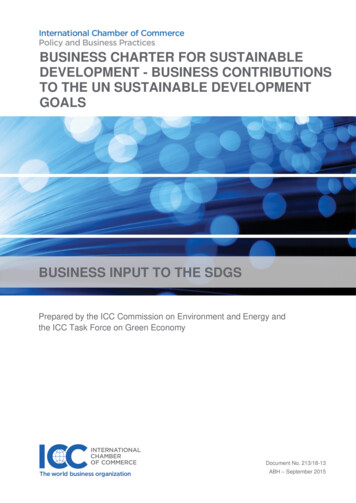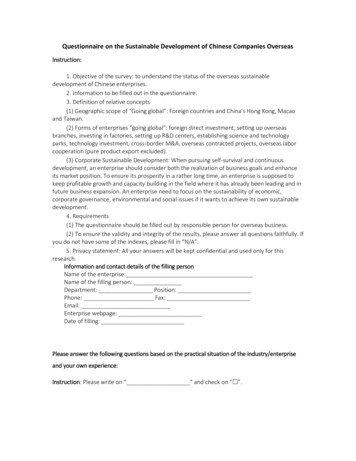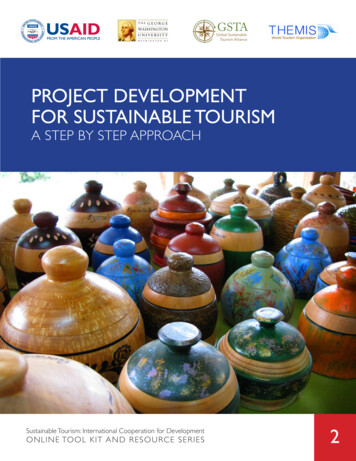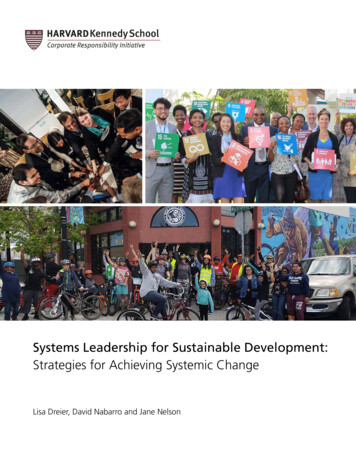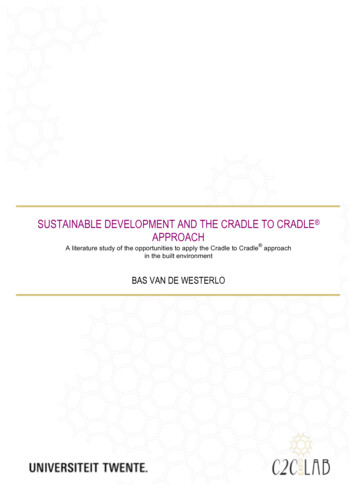
Transcription
soilSUSTAINABLE DEVELOPMENT AND THE CRADLE TO CRADLE APPROACH A literature study of the opportunities to apply the Cradle to Cradle approachin the built environmentBAS VAN DE WESTERLOBas van de Westerlo
2
Sustainable Development and the Cradle to Cradle ApproachA literature study of the opportunities to apply the Cradle to Cradle approach in thebuilt environment3
PublisherUniversity of Twente, 2011, EnschedeAuthorBas van de Westerlo, MSc.SupervisorsProf.dr.ir. J.I.M. Halman (promotor)Dr. E. Durmisevic (assistant promotor)University of TwenteUniversity of TwenteProductionOcé-Technologies B.V.St. Urbanusweg 435914 CA VenloThis publication is printed onVan Gansewinkel OfficePaperwith a Cradle to Cradle Silver 36531818For further informationC2C ExpoLAB FoundationAttn. Bas van de WesterloE: bas@c2c-expolab.euT: 31 (0)6 5518 1946I: www.c2cexpolab.euThis study was supported by the C2C ExpoLAB Foundation. The mission of C2C ExpoLAB isto support and implement the Cradle to Cradle 1 ambitions of the City of Venlo.Copyright Bas van de Westerlo, Enschede, the Netherlands.All rights reserved. Nothing in this report may be reproduced and/or published by means ofprinting, photocopying, microfilm or in any other form without the express prior writtrenpermission of Bas van de Westerlo.1Cradle to Cradle is a registered trademark of McDonough Braungart Design Chemistry, LLC (MBDC). Cradle to CradleCMCertified is a certification mark licensed by the Cradle to Cradle Products Innovation Institute. All other third-party trademarksare those of their respective owners.4
NE.83FROMECO- ‐EFFICIENTTOECO- ‐EFFECTIVEANDECO- O- ‐EFFICIENCY.123.2TRIPLEP.143.3DEFININGECO- ‐EFFECTIVENESS.153.4TRIPLEE.164CRADLETOCRADLE :PRINCIPLESANDDESIGNCRITERIA.174.1PRINCIPLE1:WASTE ECIES,CULTURALANDINNOVATIVE.224.4CRADLETOCRADLE DESIGNCRITERIA.225CRADLETOCRADLE :OLDWINEINNEWBOTTLES?.235.1PRINCIPLE1:WASTE INTHEBUILTENVIRONMENT.347.1DESIGNINGWITHBOTHSHORT- ‐TERMANDLONG- ABLE(IFD)BUILDING.367.5.BIO- CRADLETOCRADLE S.398.3.DESIGNPROCESS.398.4.CONCLUSION.405
1IntroductionFor several decades there has been a discussion in the scientific literature about sustainabledevelopment in the built environment. Even today there is still a lot of confusion about whatsustainable development really means, and how developments in this category areinterrelated. The same applies to the more recent Cradle to Cradle approach. This reviewaims to provide a literature study of sustainable development in the built environment, and toidentify the most important underlying principles.The literature study contains information from articles published in scientific and professionaljournals searched using ScienceDirect, Google Scholar and the 3TU catalog. The reviewfocuses on the period from 1962 to 2010. 1962 was the year in which, in an importantscientific contribution, Rachel Carson published her concerns about the increasing pollutionof the environment.This review provides a literature study of sustainable development in the built environment,including the associated reference framework and basic principles of the different lines ofthinking. Attention will be given specifically to the most recent Cradle to Cradle approach,which takes an important step towards the transition from a linear to a closed-cycle system,without harmful effects on the environment.This literature study formed part of the Construction Management and Engineering researchprogram at the University of Twente. This research program has an interdisciplinaryapproach, focusing on the development of innovative solutions for building. Attention forsustainable development in building forms an essential part of the research program. Thesubject-oriented approach, close links with practice and emphasis on the integration ofdisciplines are important distinguishing features of this research program to improve theperformance of the building industry.6
1.1 Research questionsThis literature study focused on the following research questions:1. What have been the most important lines of thinking in sustainable developmentduring the past 50 years?2. Which basic principles and reference framework are associated with efficientsustainable development?3. Which basic principles and reference framework are associated with effectivesustainable development?4. What are the principles of the Cradle to Cradle approach?5. Which policy initiatives to promote a sustainable society have been taken in the past50 years by the United Nations, the European Union and the Dutch government?6. Which methods, techniques and policy instruments are now available in relation to therealization of sustainable development in the built environment?7. What are the scientific challenges to the realization of efficient and effectivesustainable development in the built environment?1.2 MethodologyIn the first phase a literature study was carried out into the most important lines of thinking insustainable development. Much research into sustainable development has been performedin recent decades. Important developments are presented in publications by Carson (1962),Meadows (1972), WCED (1987), Johnson (1993), Greadel (1995), Elkington (1998),Hawkens et al. (1999), Braungart & McDonough (2002) and Gore (2006).The keywords which sources in the literature study had to contain are: sustainabledevelopment, sustainability, Eco-Efficiency and environmental problem, in the period from1962 to mid-2010.Secondly, a literature study was carried out into which policy initiatives to promote asustainable society have been taken by the United Nations, the European Union and theDutch government. A literature study was also carried out into the available methods,technologies and policy instruments for a sustainable built environment.The keywords which sources in the literature study had to contain are: sustainabledevelopment, sustainability, policy and built environment, in the period up to 2010.Thirdly, a literature study was carried out into the essential principles of the Cradle to Cradle approach. This literature study covers relevant publications and related conferenceproceedings. Important Cradle to Cradle development are presented in the publications byBraungart & McDonough (1992; 2002 & 2007).The literature study allows the basic principles and reference framework of Cradle to Cradle approach to be investigated. The keywords which sources in the literature study had tocontain are: Cradle to Cradle , Eco-Effectiveness and built environment, in the period from1992, the year in which the Hannover Principles were published, up to mid-2010.The findings of this literature study lead to an overview of sustainable development in thebuilt environment. Finally, this literature study is analysed. The analysis leads to scientificchallenges for the implementation and development of the closed-cycle approach in the builtenvironment.7
2 Sustainable development timelineWarnings have been sounded around the world since the 1960s about the deterioration ofthe environment. Partly because of these warnings, numerous proposals have been madefrom the 1980s onwards for a worldwide approach to existing and predicted environmentalproblems. The first examples of these are the World Conservation Strategy by theInternational Union for Conservation of Nature (IUCN) in 1980, and the Brundtland Report bythe World Commission on Environment and Development (WCED) in 1987. Both reportsadvocate a departure from non-sustainable consumption and production in favor ofsustainable development. The Brundtland Report defines sustainable development as a formof development that meets the needs of the present without compromising the ability offuture generations to meet their own needs. Since then, awareness of the globalenvironmental problem has clearly increased. Among the results has been the formation of anumber of lines of thinking aimed at contributing to the reduction – and ideally the completeelimination – of environmental problems.Using a timeline (see fig. 2.1), this section gives a chronological overview of the mostimportant lines of thinking in relation to sustainable development. The timeline also refers tomajor environmental disasters in the same period.Fig. 2.1. Overview of the most important lines of thinking in relation to sustainable development.1962 Silent Spring – Rachel Carson.The book Silent Spring made an important scientific contribution to public concern aboutenvironmental pollution, caused mainly by the use of pesticides. The book describes anddocuments the harmful effects of pesticides on the environment (Carson, 1962).1970 1st Earth Day – Gaylord Nelson.The former US senator Gaylord Nelson started the idea of making the world populationaware of its own consumer behavior and the resulting impact on the environment. Since1970, Earth Day has been held in more than 175 countries on 22 April each year (WorldResources Institute, 2010).8
1972 Limits to Growth – Club of Rome.This publication, ordered by the Club of Rome, focuses attention on topics including theproblem of depletion of the earth’s resources. The study is based on information from theperiod 1900 to 1970, and shows the consequences of growth trends in areas includingpopulation, pollution, industrialization, food production and depletion of fossil fuels. Limits toGrowth suggests that if the present growth trends continue the earth will no longer be able tomeet demands for natural resources by around 2100 (Meadows, 1972).1980 World Conservation Strategy (WCS) – International Union for the Conservation ofNature and Natural Resources (IUCN).The aim of the WCS is ‘to help advance the achievement of sustainable developmentthrough the conservation of living resources. The concept of sustainability arose in thecontext of fisheries and forestry. The concept was first introduced by the IUCN as‘sustainable development’ during an international forum (IUCN, 1980).1984 State of the World – Worldwatch Institute.Each year the Worldwatch Institute publishes a new State of the World book. TheWorldwatch Institute is a renowned interdisciplinary research institute, and reports annuallyon the state of the environment (Starke, 1984).1987 Brundtland Report – United Nations.The UN commission, chaired by the then Norwegian Prime Minister Gro Harlem Brundtland,published the report Our Common Future in 1987. Our Common Future is better known asthe Brundtland Report, and gives the following definition of sustainable development (WCED,1987):‘Development that meets the needs of the present without compromising the ability offuture generations to meet their own needs.’1988 Formation of the IPCC – United Nations.In 1988 the United Nations set up the Intergovernmental Panel on Climate Change (IPCC) toassess the risks of climate change and, based on scientific data, to publish these impartially.Its published reports are considered as works of reference for policy-makers, scientists,specialists and researchers (IPCC, 1990).1992 Earth Summit – United Nations.The United Nations Conference on Environment and Development (UNCED) was held in Riode Janeiro in June 1992. The Earth Summit resulted in the climate and biodiversity treaty.Also drawn up at the first Earth Summit – and of a less binding nature – were the ForestPrinciples, Rio Declaration on Environment and Development and Agenda 21. Agenda 21states international actions towards sustainable development in the 21st century. The mostimportant decision-making body in the climate treaty is the Conference of the Parties (COP),in which all parties to the convention meet annually to discuss progress (Johnson,1993).1992 Changing Course – Stephan Schmidheiny.Following the Earth Summit in Rio de Janeiro, the question arose of what possiblecontribution industry could make to the achievement of sustainable development. The bookChanging Course authored by Stephan Schmidheiny together with the World BusinessCouncil for Sustainable Development (WBCSD) presents the concept of eco-efficiency. Inmany cases ecology and economy are regarded as opposites. As a result, decisions arefrequently taken that benefit the economy and employment, but are highly environmentunfriendly. The opposite is also the case: measures are sometimes put forward that areintended to benefit the environment, but do not take into account either cost price oreconomically better alternatives. Eco-efficiency therefore aims to reconcile environment andeconomy by ‘producing more from less’: using minimal resources to work at lower cost and ina more environment-friendly way (Schmidheiny, 1992).9
1992 Hannover Principles – Braungart & McDonough.The Hannover Principles of Design: Design for Sustainability was written in 1992 byBraungart and McDonough as a guide to development for the Expo2000 World’s Fair inHannover. It presents guidelines for the design of the built environment, taking into accountfuture effects on the environment, society and sustainable growth in the longer term(McDonough & Braungart, 1992).1994 People, Planet, Profit – John Elkington.John Elkington introduced the Triple Bottom Line (TBL) in 1994 in which equal emphasis isplaced on the social, ecological and economic dimensions, better known as People, Planet,Profit (Elkington, 1998).These three factors have been adopted by numerous companies as a guideline forCorporate Social Responsibility. For the 2002 Earth Summit in Johannesburg, the P of Profitwas changed to Prosperity, to include not only profit in the economic sense but also thebenefit to society at large.1997 Kyoto Protocol – United Nations.Following the first Earth Summit, the Kyoto Protocol was drawn up by 179 countries in Japanduring COP-3. Preparations for this were made during COP-1 (1995, Berlin) for furtherdevelopment, and during COP-2 (1996, Geneva) the scientific basis was laid for the protocolby means of a second IPCC report. The protocol forms part of the climate treaty, which setsout the goals for further reduction of greenhouse gas emissions (United Nations, 1998).1999 Natural Capitalism – Hawken, Lovins & Lovins.In Natural Capitalism, creating the Next Industrial Revolution, the authors emphasize theinterrelationship of ecology and economy. According to Natural Capitalism the earth can onlycontinue to function properly by recognition of the essential relationship between ecology andeconomy. Ecological economics is an academic research area that focuses on investigatingthe influence of and the interrelationship between ecology and economy. An importantscientific challenge in the ecological economy is the question of how to build up a functioningeconomy in a specific ecosystem without damaging that ecosystem (Hawken et al., 1999).2002 Cradle to Cradle – William McDonough & Michael Braungart.In the book Cradle to Cradle : Remaking the Way We Make Things, the authors present a‘Cradle to Cradle ’ approach in which biological and technical cycles are closed withoutdamaging effects on the environment. in this approach, waste materials are turned into‘nutrients’ for a following cycle. To achieve this, the Cradle to Cradle approach uses thefollowing principles:1. Waste is food, Everything is a Nutrient for Something Else;2. Use the Sun, Use Renewable Energy Only;3. Enjoy Diversity, Species, Cultural and Innovation Diversity.This approach introduces the concept of eco-effectiveness to address the shortcomings ofeco-efficiency. Eco-efficiency aims as far as possible to reduce and compensate the harmfuleffects on the environment. Eco-effectiveness aims for development without harmful effectson the environment. The aim of the Cradle to Cradle approach of Braungart andMcDonough (2002) is: ‘A delightfully diverse, safe, healthy and just world, with clean air,water, soil and power – economically, equitably, ecologically and elegantly enjoyed’.2006 An Inconvenient Truth – Al Gore.An Inconvenient Truth is the movie in which former US Vice President Al Gore tours theworld to ventilate his concerns about climate change and the dismissal by politicians of theassociated risks. To do this he uses high-impact images of the effects of hurricanes, glaciersfalling into the sea, drought and desertification. He shows on a map that around half of the10
Netherlands would disappear under water as a result of global warming. Gore also wrote abook of the same title. The book and the movie succeeded in bringing the expected climatecrisis and climate change to the attention of a very broad public audience (Gore, 2006).2009 United Nations Framework Convention on Climate Change (UNFCCC) – UnitedNationsFollowing the first Earth Summit and the subsequent COPs, COP-15 was held inCopenhagen in 2009 to reach a new international climate treaty. The aim of the UNFCCC isto make binding agreements for a new international climate treaty from 2012, which is whenthe binding agreements in the Kyoto protocol expire. The conference was attended by 192countries, although it did not result in binding agreements (UNFCCC, 2009).2010 United Nations Framework Convention on Climate Change (UNFCCC) – UnitedNationsAfter the failed negotiations during the climate summit in Copenhagen (2009), thediscussions about a new international climate treaty were continued in Cancun, Mexico. Atthe UN Climate Change Conference in Cancun 190 countries reached a new agreement onmeasures against climate change. The most important agreements are on measures againstdeforestation and the setting up of a Green Climate Fund to enable developing countries tofight climate change. New agreements were also reached about reducing CO2 emissions.The agreements were intended to form the basis for a finalized treaty to be signed thefollowing year in Durban, South Africa (UNFCCC, 2010).11
3 From eco-efficient to eco-effective and eco-efficient sustainabledevelopmentFollowing the Earth Summit in Rio de Janeiro (1992), the question arose of what the possiblecontribution of industry could be to achieving sustainable development. Eco-efficiency aimsto reconcile environment and economy by ‘producing more from less’: using minimalresources to work at lower cost and in a more environment-friendly way. The core of ecoefficiency can be summarized as: ‘get more from less’. More products or services with lesswaste, less use of materials and lower harmful emissions. This section addresses the basicprinciples and the reference framework of efficient and effective sustainable development inthe built environment.3.1 Defining Eco-EfficiencyAfter this Earth Summit, 50 of the world’s largest companies analysed the applicability of theconcept of sustainable development. In the book Changing Course, these companiesintroduced a strategy to achieve this sustainable development. This strategy followed an ecoefficient approach, defined as: ‘Companies that continuously create more usable productsand services – that add value – while also continuously reducing the consumption ofresources and the production of emissions’ (Schmidheiny, 1992).In line with the above definition, the World Business Council for Sustainable Development(WBCSD) investigated the application of eco-efficiency in industry and reached the followingdefinition: ‘Eco-efficiency is achieved by the delivery of competitively-priced goods andservices that satisfy human needs and bring quality of life, while progressively reducingecological impacts and resource intensity throughout the life-cycle to a level at least in linewith the earth’s estimated carrying capacity’ (WBCSD, 2000). Based on the strategy of ecoefficiency, innovative strategies have been developed focusing on reduction andcompensation of harmful effects on the environment.Governments and companies have adopted eco-efficiency as a guiding strategy. Table 3.1shows the definitions of (eco-)efficiency used by some of these organizations:Table 3.1. Definitions of Eco-Efficiency.SourceDefinitionAustralian Government*Eco-Efficiency is a management process that is designed to ‘produce morefrom less’. Eco-efficiency can be achieved by increasing mineral recovery,using fewer inputs such as energy and water, recycling more an reducingemissions.Eco-Efficiency is the amount of ‘environment’ used per unit of economicactivity.The relationship between economic output (product, service, activity) andenvironmental impact added caused by production, consumption anddisposal.The ability of a managed entity to simultaneously meet cost, quality, andperformance goals, reduce environmental impacts, and conserve valuableresources.Eco-Efficiency, cleaner production and lean production are based on acommon philosophy: to reduce ‘waste’ in all steps of a production process.Eliminating waste will lead to improvements in eco-efficiency and thuscontributes to: less energy consumption, less waste materials, lessmaterials handling, and less intermediate storage.This strategy induces the integration of cleaner production technology intothe production process, aiming at a reduction in materials and energyconsumption and thus at a decrease in pollution.The means by which more and better goods and services are created usingfewer recourses and minimizing waste and pollution. In practice, ecoefficiency has three core objectives: increasing product or service values,optimizing the use of resources, and reducing environmental impact.European Environmental Agency*Global DevelopmentCenter*Joseph Fiksel*Klaus North*Laurent Grimal*LEAN Advisors*Research12
Nokia*Eco-Efficiency means producing better results from less material andenergy. For us this means: minimizing energy intensity, minimizing thematerial intensity of goods and services, extending product durability,increasing the efficiency of processes, minimizing toxic dispersion,promoting recycling, and maximizing the use of renewable resources.Eco-Efficiency is a concept that links environmental and financialperformance. It does this by focusing on the development, production anddelivery of products and services that meet human needs whileprogressively reducing their environmental impact throughout theirlifecycles. Eco-efficiency essentially means doing more with less-usingenvironmental resources more efficiently in economic processes. Theapplication of eco-efficiency is undertaken, but not limited, by approachesand instruments such as cleaner production and environmentalmanagement systems.Eco-Efficiency is calculated by dividing the value of a product by theproduct’s ‘environmental impact’. The smaller the environmental impact andthe higher the value of the product, the greater the eco-efficiency. The valueof a product is calculated based on its functions and performance, taking thevoice of customer into consideration. The environmental impact iscalculated, taking into consideration various environmental impactsthroughout its life cycle.Maximizing efficiency of production processes while minimizing impact onthe environment. Eco-efficiency can be achieved by using new technology,using fewer inputs per unit of product such as energy and water, recyclingmore and reducing toxic emissions. In summary doing more with less.PrintNet*Toshiba Group*WMC Resources Ltd.** Source: Braungart & McDonough, 2006Critics respond to eco-efficiency by calling for effective, instead of efficient, options. Theybelieve that eco-efficiency results in the development of short-term solutions. WBCSDrecognizes that effectiveness goes further than simply improving existing systems. Butaccording to WBCSD the concept of eco-efficiency is not intended as an all-encompassingpanacea. It is therefore all the more important to emphasize what, according to the WBCSD,eco-efficiency is not. See Fig. 3.1.What eco-efficiency is not: Not a take-it-or-leave-it approach Not an either-or (but much more a bothand-and) approach Not a solution to all the problems on theway to sustainability Not a rigid framework Not anyone’s single strategy Not a management system Not a certifiable standard Not a reporting format Not a cook-book with recipes Not something one can buy off the shelf Not an assurance against failure.Fig. 3.1. What eco-efficiency is not (WBCSD, 2000).13
Efficiency can certainly be valuable if it is implemented as a tool in an effective system that isintended to create a positive effect in a range of areas. Efficiency is also valuable when it isapplied as a transitional strategy to delay current systems that are harmful to theenvironment in such a way that they can lead to change. Steelcase (2001) uses theEnvironmental Strategies Scale as a tool to classify practical solutions in relat
Thirdly, a literature study was carried out into the essential principles of the Cradle to Cradle approach. This literature study covers relevant publications and related conference proceedings. Important Cradle to Cradle development are presented in the publicati
